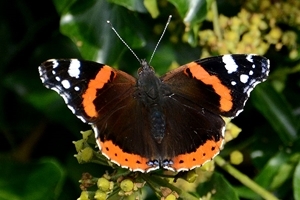Red admiral
 2017 appears to be a good year for red admirals (Vanessa atalanta), and October can be a great month to spot these beautiful butterflies. Choose a bright day and find yourself a large clump of ivy that has the sun beaming down on it. Ivy is in full flower at this time of year, and along with bees, wasps and many other species of insect, butterflies such as the red admiral will also be found nectaring on these autumnal flower heads.
2017 appears to be a good year for red admirals (Vanessa atalanta), and October can be a great month to spot these beautiful butterflies. Choose a bright day and find yourself a large clump of ivy that has the sun beaming down on it. Ivy is in full flower at this time of year, and along with bees, wasps and many other species of insect, butterflies such as the red admiral will also be found nectaring on these autumnal flower heads.
Another top place to look for them at this time of year is on fallen fruit, especially apples and plums. Over-ripe blackberries can also attract them.
Red admirals are one of the best known and loved butterflies, probably because they are quite large and showy, with their distinctive orange (not really red!) streaks on a black background, finished off with white spots near to the wing tips.
The name ‘red admiral’ apparently comes from a corruption of the original 18th-century name ‘red admirable’. I rather like the French name for it too: Le Vulcain, meaning the Vulcan, the god of fire, which particularly includes the fire created by volcanoes, conjuring up the orangey scarlet flames against the inky black igneous rocks – wonderfully describing the admiral’s colouration!
If you watch a red admiral for a while, especially in this country, the chances are that the sun will go behind a cloud before too long, and when that happens the butterfly will probably close its wings to conserve warmth. The instant this happens, an eye-catching insect virtually disappears within a second! In my opinion, the underside of the wing is also spectacular, albeit in a more subtle way. A mixture of blues, whites and pinks collected around the edge of the wing, merge into a myriad of dark, mottled tortoiseshell colours, camouflaging the insect perfectly into the background.
Early in the year, red admirals start a northward migration from North Africa and continental Europe. The first admirals to be spotted here in spring, sometimes as early as February, may well have managed to overwinter in the south of England as adults, although usually our winters are too harsh for them to survive. Climate change may well be resulting in more adult admirals managing to successfully overwinter here.
The immigrant females mate and lay eggs, usually on stinging nettles, resulting in a new batch of adults hatching out from around mid-July onwards. It is these fresh, second-generation butterflies that we are observing in the autumn months and, depending on the weather, they can still be putting in an appearance right up until Christmas!
The number of adults seen in any one year is dependent on the quantity of migrants reaching us. In some years, red admirals can be widespread and common, spreading as far north as the top of Scotland and even the Shetland Isles, but in other years they can be surprisingly scarce.
There is increasing evidence that second-generation red admirals born here and across northern Europe do start to migrate back south again during the late summer. Ornithologists in Finland recorded the autumn migration of the red admirals (they were high up in an observation tower, looking out for migrating birds). In 1998, a particularly good year, 1,240 migrants were counted moving south, representing some half a million butterflies migrating through a 100km front.
The butterflies were flying above forests, using cool northerly winds to aid them on their journey southwards. Radar also indicated that a large proportion of the butterflies migrated at great height, well outside the visible range of humans on the ground, or even up a bird observation tower!
So, there you have it. A wonderful butterfly that will hopefully ignore all the current fuss over Brexit, and continue to arrive on our shores every spring for many, many years to come!
Peter Thompson
Advisory

Download Peter Thompson's essential 26-page book, featuring beautiful photography and detailed profiles of Britain's wildlife
Download FREE >